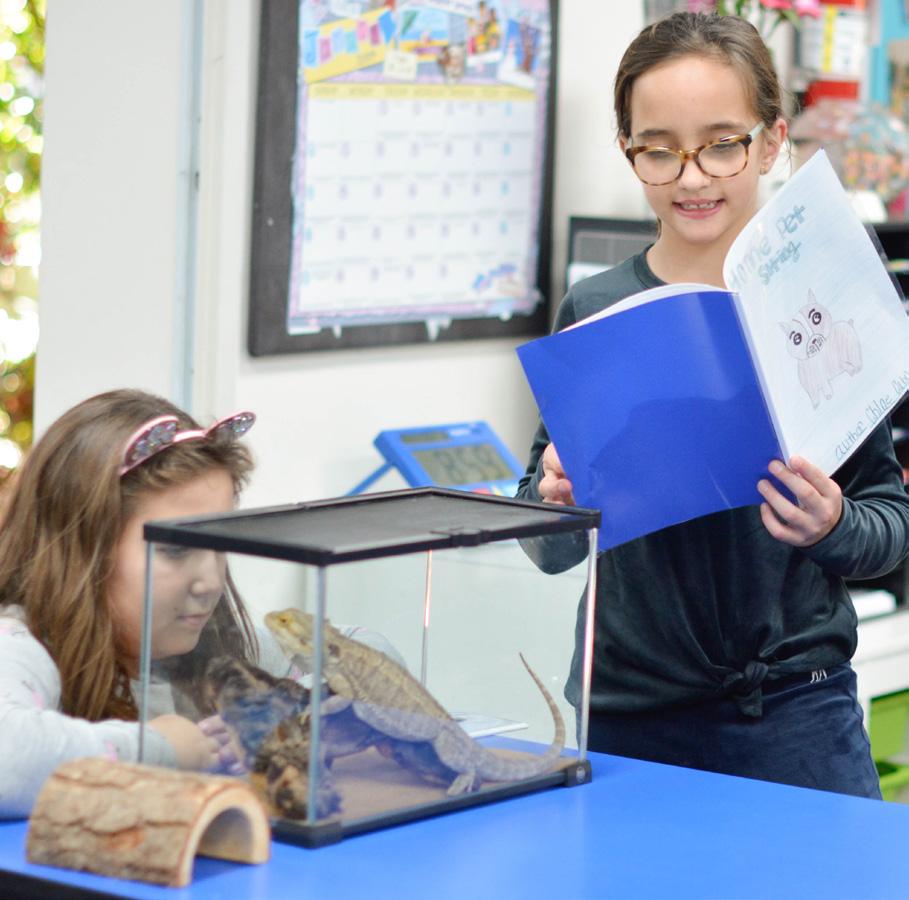SPONSORED
WRITE How to Help Young ON: Writers Find Their Spark by Courtney Cairns Pastor, photos provided by Corbett Preparatory School of IDS
Corbett Prep seventh graders begin November as regular English students and end the month as novelists. Prekindergarten children dive into literacy by starring in a book their teachers write and read to them. Third and fourth graders host read-alouds of their original work before an audience of fuzzy, four-legged friends. Writing can unleash some students’ imaginations and provide them with an outlet for self-expression. Other students struggle to put pencil to paper. But with a fresh approach to the process, all students can benefit from developing writing skills, whether they are writing Oprah’s next book club pick or responding to prompts in class.
A solid writing foundation helps students become better communicators – important for school and the workforce. Writing practice develops organized thinking, improves reading ability and stokes the imagination. Writing makes “thinking visible,” according to the National Writing Project, and opens writers to new perspectives as they conduct research, solicit feedback and transform scattered thoughts into compelling messages. For new or reluctant writers, here are some strategies Corbett Prep teachers use to introduce students of all ages to writing and help them find their spark. Read, read and read some more: Good writers are readers. When you read to your child, go beyond the story itself so they can learn to appreciate books and writing. Preschool students are curious about how books work. How does the story get in the book? What kinds of jobs are involved in making a book? Corbett Prep’s PreK3 class kicks off its literacy unit with “We Are in a Book.” Teachers generate excitement about reading and writing by creating a personalized book starring the class, which leads to conversations about how to tell stories and who can write them (answer: anyone). Older students can build on these types of discussions, talking about what makes a novel a novel and what techniques keep them reading. Understanding what they enjoy and how an author plots a novel’s storyline can help them when they sit down to try it themselves. If it’s a challenge just to get your child reading, remember that reading takes place in many forms. Audiobooks and graphic novels
have as much value as chapter books. The chance to read with others also motivates students. Some Corbett Prep third and fourth graders meet on Zoom weekly after school for book club discussions, and sixth graders work together in small book circles to choose and discuss a novel for class. Book clubs can work at home, too, when parents or siblings agree to read the same stories. Relax your definition of writing: Lists, poems, songs, emails, notes – it’s all writing! Experiment with different formats to see what clicks with your children. They may enjoy passing notes to mom and dad. Or maybe they want to email grandma instead of writing a note by hand. Some kids like to create games, so have them write out the rules they make up as well. If your goal is writing practice, any of these forms are fine. Even students who are just learning to write and spell can tell great stories. Corbett Prep second-grade teacher Aimee Popalis helps her students take their writing to the next level through drawing. Students plot out their stories by illustrating the beginning, middle and end. Their pictures often include small details about settings and characters that students can incorporate into their writing. An unusual audience also makes writing fun. Teacher Ann Cashen captured the interest of third and fourth graders by soliciting pet stories. Students wrote animal adventures with the goal of creating a short book that they could read to an audience of pets. Families brought pets to school – dogs, cats, rabbits and, once, a horse! – and students rotated among their furry guests to share their stories. Just write. Corbett Prep’s seventh grade took on National Novel Writing Month, also known as NaNoWriMo, a creative writing challenge to write a novel in one month. NaNoWriMo asks students to think about when they need their inner editors and when to let them go. Students set word count goals and learned to embrace their rough drafts. Regular freewriting without worrying about spelling and grammar gets creative juices f lowing, breaks through writers’ block and improves writing f luency. Students working on their novels can play with language, story and characters and take chances they might shy away from when writing for a grade. At home, give your children journals to pour out their thoughts privately. And remember, if your kids show you their journaling or fun writing, try to resist the urge to criticize or correct unless asked. The important part is cultivating an interest in writing. Perfection can wait. MARCH 2021 TampaBayParenting.com
33

















